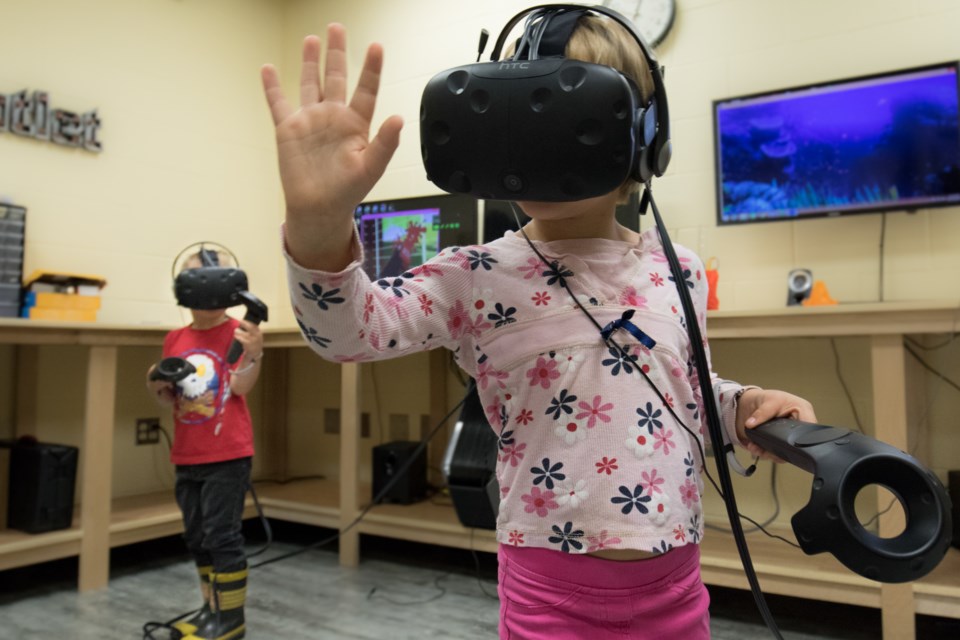Northern College says that, as a college, it has one of the most advanced virtual reality labs in the world – and the equipment is freely available for the general public’s use.
This fall, the college installed two new state-of–the-art HTC Vive VR systems.
The new equipment lets people not only look through virtual reality but, by mapped sensors and movements, allows people to actually move through 3D Space.
The new VR setup was publicly launched on the first day of the semester.
Not only can users move through complex 3D virtual world simulations but by the tracking of hand movements via sensors in nunchuck-style controllers, they can grab and touch virtual objects.
For example, using the hand controllers, students are able to have light saber battles in immersive virtual spaces.
Movements like ducking, bending down, jumping, looking around, and arm movements are all tracked.
There is a powerful sense of immersion, or rather, lack of a sense.
“It’s very cool. It takes a little time to get used to it but wearing it after a while you don’t even notice it,” said William Church, who is studying to be a heavy machine mechanic at the college.
The VR devices are already being used as teaching aids in for-credit courses and outside of class.
Students in the nursing program are reportedly using the machines outside of class to take virtual anatomy tours, from inside the organs of the body.
“It’s kind of like the Magic School Bus,” said senior library technician Shannon Arsenault, who manages the day-to-day use of the VR machines in the Learning Centre.
The school first experimented with VR technology when business professor William Durocher advocated for its use in the college.
Last summer, Durocher designed an Indigenous Cultures module using 360 degree cameras to be watched with VR headsets.
At that time the school had an Oculus Rift VR machine that was mostly used while seated using a standard video game controller.
Durocher and his team travelled to Moose Factory, Moosonee, and locations in British Columbia, capturing indigenous experiences with storytelling.
The intention was to give non-indigenous students an ‘experience’ of First Nations culture.
While some of the school's 360 degree footage is available on Youtube and can be watched in any regular web browser, when the VR technology is mixed in it’s a very immersive experience.
Durocher said Northern College is “among the first (colleges) worldwide” to implement VR technology.
As an advocate for the technology, he has sees a very promising future for it.
“The state of the technology right now is that we’re dabbling in it. We’re trying to find ways to get it into education and it will be part of normal (for-credit) education soon but its not formally integrated into too many places yet. We’re looking to lead the way in VR and education,” said Durocher.
Durocher explained there are basically two ways to implement the VR technology: through 360-degree video and through simulations.
The 360 degree video, which perhaps the general public is familiar with at this point, when mixed with a VR headset, reacts to a viewer's head movements to create the experience of looking around a 3D space.
The simulation technology, that most games and advanced applications use, allows a person to move through the 3D world.
Durocher said the ‘experiential’ aspect of this opens up a range of new learning possibilities like eradicating accessibility barriers for people with disabilities, allowing students access to virtual facilities or in providing virtual access to operating rooms when real life ones are not available.
For the most part, the machines are being used by students to play games.
“What we’d like to see is people start creating and programming their own spaces, not only for gaming ideally. Perhaps something where you can design a building or other piece of architecture and see your design, perhaps the flaws in the design before you spend tons of money building it. Those kinds of applications are what we’d like to find,” said Arsenault.
Although VR may seem new and exciting now, Durocher said he believes it will become commonplace, probably faster than you think.
“Right now it's cutting edge, my course is the first in Canada, (however) I want to emphasize the point that this technology is going to be widely democratised in the next five years. It will become an increasingly important mode of educational delivery,” he said.
The equipment was brought to Northern College by a joint partnership between the Northern College Entrepreneurship Centre and the Learning Centre.
It is housed in the college’s Creative Outlet, an on-campus maker space that also includes 3d Printers, a CNC machine, electronics and computer making kits, sewing equipment, and a simple room to brainstorm thoughts nicknamed ‘The Idea Generation Chamber’.
Some of the software Northern College has available to use with its VR sets includes:
Job Simulator – a tongue-in-cheek game that attempts to simulate the experience of an auto mechanic, store clerk, office worker, and more
The Lab – a virtual world with several mini-games that utilize the potential hand control of the HTC Vive, perhaps people will most enjoy pretending to shoot things with a bow and arrow in it
Funhouse – a virtual world of carnival games
Rec Room – this includes Paintball, Dodgeball, 3d Charades, and Disc Golf
The Blu – a graphically rich underwater experience
Tilt Brush – You know Microsoft Paint? This is like that but 3d
The Body VR – a way to virtually explore the anatomy of the body by journey through the bloodstream and into organs



